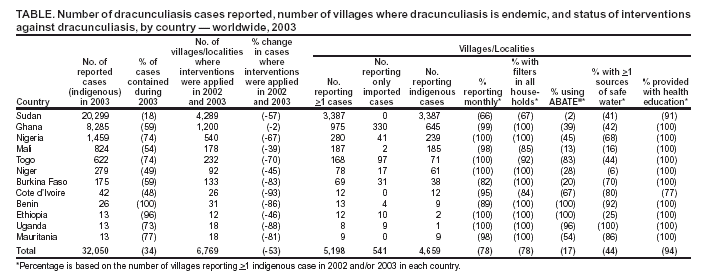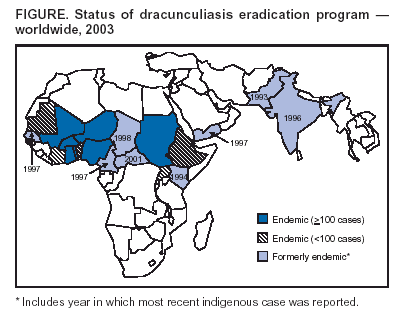 |
|
|
|
|
|
|
| ||||||||||
|
|
|
|
|
|
|
||||
| ||||||||||
|
|
|
|
|
Persons using assistive technology might not be able to fully access information in this file. For assistance, please send e-mail to: mmwrq@cdc.gov. Type 508 Accommodation and the title of the report in the subject line of e-mail. Progress Toward Global Eradication of Dracunculiasis, 2002--2003In 1986, when the World Health Assembly adopted a resolution calling for the eradication of dracunculiasis (i.e., Guinea worm disease), an estimated 3.5 million cases occurred in 20 countries, and 120 million persons were at risk for the disease (1). This report describes the status of the global dracunculiasis eradication program (DEP)* as of the end of 2003 (2,3). The findings indicate substantial overall progress towards eradication in 2003 compared with 2002, a major reduction in cases in Sudan, and an increase in cases in Ghana. Further progress will require 1) increased surveillance in all areas in which dracunculiasis is endemic or was previously endemic, 2) access to areas that lack security, and 3) concentrated efforts in Sudan once peace is achieved. By the end of 2003, annual incidence of dracunculiasis had been reduced >99% from that estimated in 1986, and eight countries in which the disease was previously endemic (Cameroon, Central African Republic, Chad, India, Kenya, Pakistan, Senegal, and Yemen) were free of the disease. Of the remaining 12 countries in which dracunculiasis remains endemic, five reported <100 cases each (Benin, Cote d'Ivoire, Ethiopia, Mauritania, and Uganda) (Figure). During 2002--2003, the number of cases reported worldwide decreased 41% (from 54,683 to 32,193), and the number of villages reporting >1 case decreased 26% (from 6,255 to 4,659). Of the remaining dracunculiasis cases, 89% were reported in Sudan (63%) and Ghana (26%). Of the 143 cases that were exported from one country to another during 2003, a total of 58 were exported from Ghana, 40 from Sudan, 23 from Mali, eight each from Niger and Togo, four from Nigeria, and two from Cote d'Ivoire (4). National programs intensified their interventions in most areas during 2003 compared with 2002 (Table). However, the percentage of cases that were reportedly contained in 2003 remained <75% for nine of the 12 countries. A case of dracunculiasis is classified as contained if three conditions are met: 1) the infected person is detected within 24 hours of the emergence of the Guinea worm through the skin, 2) actions (e.g., occlusive bandages, counseling, and care of the patient until the worm is extracted) are taken to prevent the person from contaminating sources of drinking water, and 3) the previous two conditions are confirmed by a health-care provider within 7 days of the occurrence. Sudan reported 51% fewer cases in 2003 (20,299 cases from 3,407 villages; reporting rate†: 66%) than in 2002 (41,493 cases from 4,333 villages; reporting rate§: 74%). Sudan's DEP is accessing more villages than ever (approximately 6,200) as a result of the official ceasefire observed since October 2002 as part of peace negotiations to end the civil conflict. This program continues to prepare for intensified activities after a possible peace agreement, but the conflict in southern Sudan remains the greatest impediment to the Sudanese and global eradication campaigns. However, during 2003, the northern states of Sudan reported no indigenous cases for the first time since reporting began, experiencing only imported cases (n = 298) from the south of the country. Ghana reported 8,290 cases in 2003, a 48% increase compared with 2002 (5,611); of these, 7,879 (95%) were reported in 15 of the country's 110 districts. This increase is attributable to improved surveillance, several unexpected outbreaks, and inadequate interventions in villages where dracunculiasis was known to be endemic during 2002. Increased cases offset substantial reductions in cases in some districts during the latter half of 2003. The top five districts where dracunculiasis is endemic, which reported 26% of all Ghana's cases in 2002, reduced their numbers of cases by 37.5% (from 1,486 to 929) during July--December 2002 and the first 6 months of 2003. However, overall cases in the top 15 districts where dracunculiasis is endemic increased 7.0% during the same period (from 2,327 to 2,491), mainly because of increases in cases of >1,000% in Nkwanta (from 54 to 584) and Savelugu-Nanton (from 15 to 228) districts. During 2002--2003, Ghana reduced by 2% (from 5,611 to 5,508) the number of cases in the villages where dracunculiasis is known to be endemic in which authorities intervened in 2002. During 2002--2003, Nigeria and Togo reduced their indigenous cases by 62% (from 3,820 to 1,459) and 58% (from 1,502 to 669), respectively, and increased reported rates of case containment from 66% to 74% and from 62% to 74%, respectively. In Mali and Niger, where lack of security delayed interventions among nomadic Tuareg populations until late 2001 and late 2002, respectively, cases were reduced by 4% (from 861 to 829) and increased by 20% (from 248 to 293). Lack of security remains a critical limiting factor for the programs in Cote d'Ivoire, Ethiopia, Sudan, and Uganda. Reported by: World Health Organization Collaborating Center for Research, Training, and Eradication of Dracunculiasis; The Carter Center, Atlanta, Georgia. Div of Parasitic Diseases, National Center for Infectious Diseases, CDC. Editorial Note:Dracunculiasis is a parasitic infection caused by Dracunculus medinensis. Persons become infected by drinking water from ponds contaminated by copepods (water fleas) that contain immature forms of the parasite. One year later, adult worms approximately 1 meter (40 inches) in length emerge through skin lesions, usually on the lower limbs, which frequently develop severe secondary bacterial infections. No effective treatment or vaccine for the disease exists, and infected persons do not become immune to future infections by the parasite. However, dracunculiasis can be prevented by 1) filtering drinking water through a finely woven cloth, 2) treating contaminated water with the larvicide ABATE® (temephos), 3) educating persons to avoid entering water sources when Guinea worms are emerging from their bodies, and 4) providing clean water from bore-hole or hand-dug wells (5). The 12 remaining countries where dracunculiasis is endemic made substantial progress toward eradication in 2003, which reflects intensification of interventions in most areas during 2002. Further improvements in public awareness are expected as a result of targeted mass media campaigns in the three countries with the most cases (Ghana, Nigeria, and Sudan). In September 2003, a joint program review was held at The Carter Center (Atlanta, Georgia) for the three countries. The delegations included senior ministerial representatives and technical leaders of the eradication programs. All 12 countries developed specific programmatic objectives for 2004; improving interventions remains a key objective. Major obstacles to rapid completion of the campaign include 1) ongoing lack of security in areas of western Africa where dracunculiasis is endemic (e.g., Cote d'Ivoire) and 2) limited funding to meet the challenges of eradicating dracunculiasis in postwar Sudan. All countries should implement daily surveillance in communities where dracunculiasis is known to be endemic to ensure detection and containment as soon as any worm begins to emerge. Moreover, all countries in which dracunculiasis is endemic should implement improved surveillance in large areas in which the disease was previously endemic. References
* Major program partners include the ministries of health in 20 countries where dracunculiasis is or was endemic, The Carter Center, United Nations Children's Fund (UNICEF), World Health Organization, Bill and Melinda Gates Foundation, other bilateral donors, U.S. Peace Corps, and CDC. † Percentage of villages where dracunculiasis was known to be endemic during 2002--2003 that reported >1 indigenous case in 2003. § Percentage of villages where dracunculiasis was known to be endemic during 2001--2002 that reported >1 indigenous case in 2002. Table  Return to top. Figure  Return to top.
Disclaimer All MMWR HTML versions of articles are electronic conversions from ASCII text into HTML. This conversion may have resulted in character translation or format errors in the HTML version. Users should not rely on this HTML document, but are referred to the electronic PDF version and/or the original MMWR paper copy for the official text, figures, and tables. An original paper copy of this issue can be obtained from the Superintendent of Documents, U.S. Government Printing Office (GPO), Washington, DC 20402-9371; telephone: (202) 512-1800. Contact GPO for current prices. **Questions or messages regarding errors in formatting should be addressed to mmwrq@cdc.gov.Page converted: 9/23/2004 |
|||||||||
This page last reviewed 9/23/2004
|